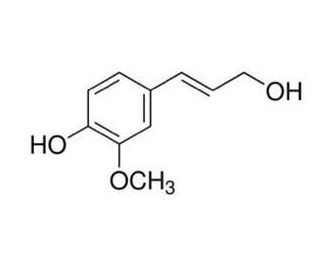Coniferyl alcohol is an important intermediate used in biosynthesis of eugenol and of stilbene and coumarin. It is also one of the preferred substrate of the eucalpytus globus enzyme and was used once as a fungal growth inhibitor
Physicochemical Properties
| Molecular Formula | C10H12O3 |
| Molecular Weight | 180.2005 |
| Exact Mass | 180.079 |
| CAS # | 458-35-5 |
| Related CAS # | (E)-Coniferyl alcohol;32811-40-8 |
| PubChem CID | 1549095 |
| Appearance | Off-white to light yellow solid powder |
| Density | 1.198g/cm3 |
| Boiling Point | 163-165 °C3 mm Hg(lit.) |
| Melting Point | 75-80 °C(lit.) |
| Flash Point | 163-165°C/3mm |
| Vapour Pressure | 6.93E-07mmHg at 25°C |
| Index of Refraction | 1.685 |
| LogP | 1.406 |
| Hydrogen Bond Donor Count | 2 |
| Hydrogen Bond Acceptor Count | 3 |
| Rotatable Bond Count | 3 |
| Heavy Atom Count | 13 |
| Complexity | 168 |
| Defined Atom Stereocenter Count | 0 |
| SMILES | COC1=C(C=CC(=C1)/C=C/CO)O |
| InChi Key | JMFRWRFFLBVWSI-NSCUHMNNSA-N |
| InChi Code | InChI=1S/C10H12O3/c1-13-10-7-8(3-2-6-11)4-5-9(10)12/h2-5,7,11-12H,6H2,1H3/b3-2+ |
| Chemical Name | 4-[(E)-3-hydroxyprop-1-enyl]-2-methoxyphenol |
| HS Tariff Code | 2934.99.9001 |
| Storage |
Powder-20°C 3 years 4°C 2 years In solvent -80°C 6 months -20°C 1 month |
| Shipping Condition | Room temperature (This product is stable at ambient temperature for a few days during ordinary shipping and time spent in Customs) |
Biological Activity
| References |
[1]. New components of the honey bee (Apis mellifera L.) queen retinue pheromone. Proc Natl Acad Sci U S A. 2003 Apr 15;100(8):4486-91. [2]. Soluble phenylpropanoids are involved in the defense response of Arabidopsis against Verticillium longisporum. New Phytol. 2014 May;202(3):823-37. [3]. Plant Cell Rep.2014 Aug;33(8):1263-74. |
| Additional Infomation |
Coniferol is a phenylpropanoid that is one of the main monolignols, produced by the reduction of the carboxy functional group in cinnamic acid and the addition of a hydroxy and a methoxy substituent to the aromatic ring. It has a role as a monolignol, a mouse metabolite, a pheromone, an animal metabolite, a plant metabolite and a volatile oil component. It is a phenylpropanoid and a member of guaiacols. It is functionally related to an (E)-cinnamyl alcohol. Coniferyl alcohol has been reported in Magnolia officinalis, Paecilomyces fulvus, and other organisms with data available. See also: Polignate Sodium (monomer of); Ammonium lignosulfonate (monomer of); Calcium lignosulfonate (20000 MW) (monomer of) ... View More ... |
Solubility Data
| Solubility (In Vitro) |
DMSO : 36~100 mg/mL ( 199.77~554.94 mM ) Ethanol : ~36 mg/mL Water : ~15 mg/mL |
| Solubility (In Vivo) |
Solubility in Formulation 1: ≥ 2.08 mg/mL (11.54 mM) (saturation unknown) in 10% DMSO + 40% PEG300 + 5% Tween80 + 45% Saline (add these co-solvents sequentially from left to right, and one by one), clear solution. For example, if 1 mL of working solution is to be prepared, you can add 100 μL of 20.8 mg/mL clear DMSO stock solution to 400 μL PEG300 and mix evenly; then add 50 μL Tween-80 to the above solution and mix evenly; then add 450 μL normal saline to adjust the volume to 1 mL. Preparation of saline: Dissolve 0.9 g of sodium chloride in 100 mL ddH₂ O to obtain a clear solution. Solubility in Formulation 2: ≥ 2.08 mg/mL (11.54 mM) (saturation unknown) in 10% DMSO + 90% (20% SBE-β-CD in Saline) (add these co-solvents sequentially from left to right, and one by one), clear solution. For example, if 1 mL of working solution is to be prepared, you can add 100 μL of 20.8 mg/mL clear DMSO stock solution to 900 μL of 20% SBE-β-CD physiological saline solution and mix evenly. Preparation of 20% SBE-β-CD in Saline (4°C,1 week): Dissolve 2 g SBE-β-CD in 10 mL saline to obtain a clear solution. Solubility in Formulation 3: ≥ 2.08 mg/mL (11.54 mM) (saturation unknown) in 10% DMSO + 90% Corn Oil (add these co-solvents sequentially from left to right, and one by one), clear solution. For example, if 1 mL of working solution is to be prepared, you can add 100 μL of 20.8 mg/mL clear DMSO stock solution to 900 μL of corn oil and mix evenly. Solubility in Formulation 4: 10% DMSO+40% PEG300+5% Tween-80+45% Saline: ≥ 2.08 mg/mL (11.54 mM) (Please use freshly prepared in vivo formulations for optimal results.) |
| Preparing Stock Solutions | 1 mg | 5 mg | 10 mg | |
| 1 mM | 5.5494 mL | 27.7469 mL | 55.4939 mL | |
| 5 mM | 1.1099 mL | 5.5494 mL | 11.0988 mL | |
| 10 mM | 0.5549 mL | 2.7747 mL | 5.5494 mL |
